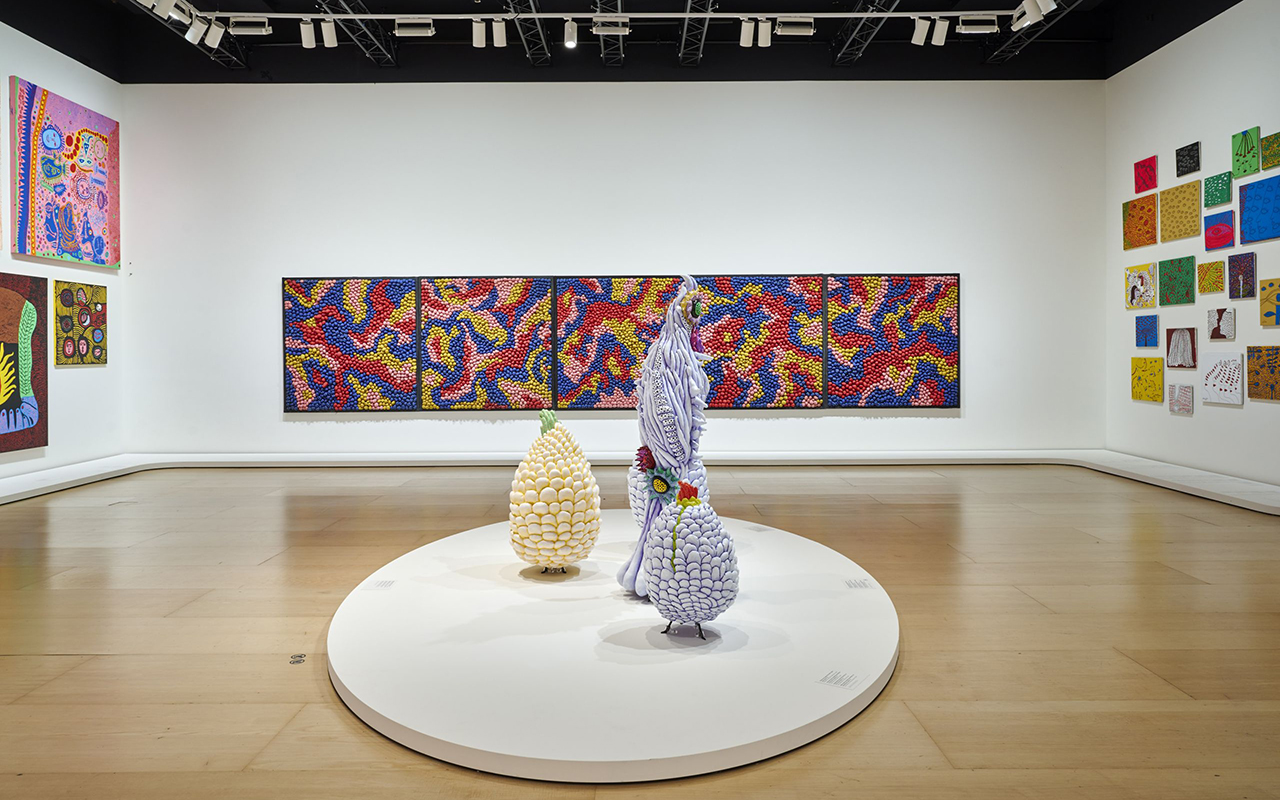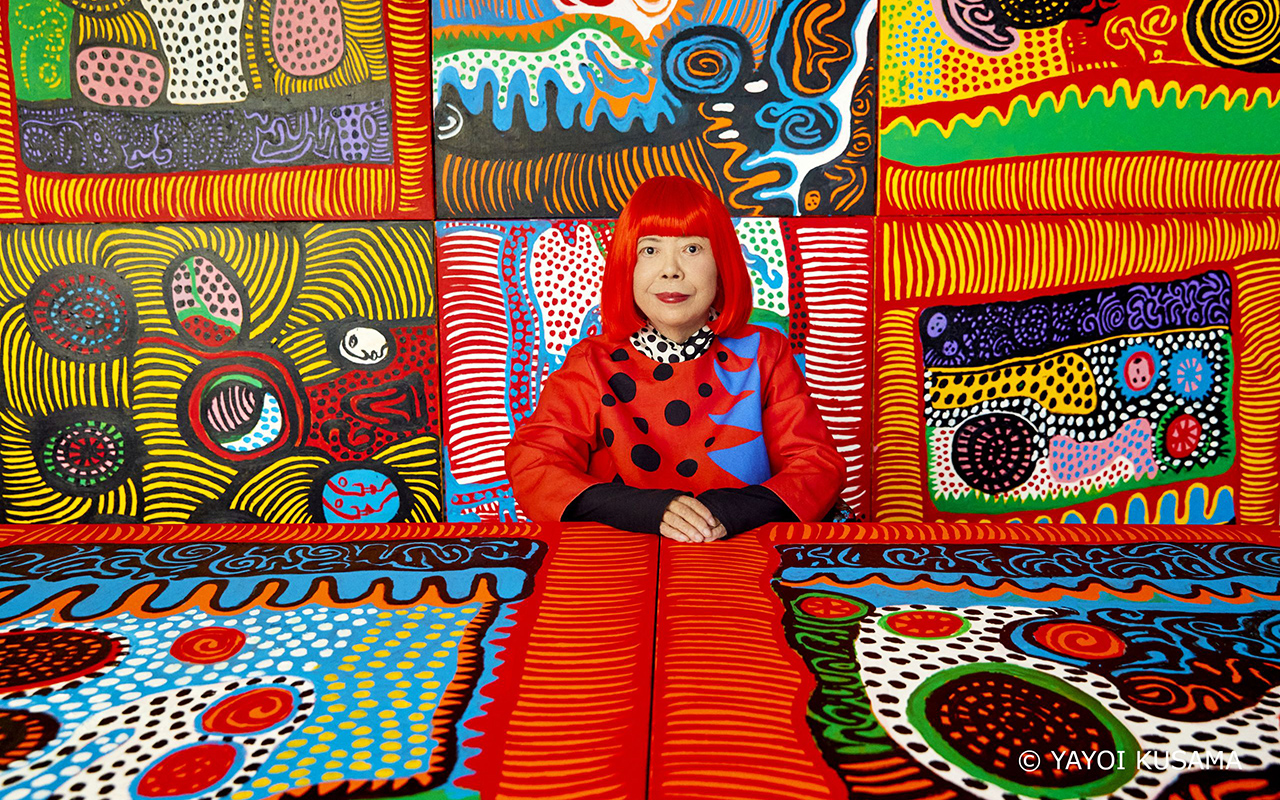
Portrait of Yayoi Kusama. Courtesy of Ota Fine Arts, Victoria Miro, and David Zwirner © YAYOI KUSAMA. Photo: Yusuke Miyazaki.
She is considered a living legend, a revolutionary who has stood out in multiple artistic movements from the 1960s to the present, an admired visual artist capable of connecting art with fashion through her unique universes, full of geometries. Or rather polka dots, her most identifying feature. Yayoi Kusama (Matsumoto, Nagano, 1929), yes the flesh and blood one -and not the hyper-realistic robotic figure that Louis Vuitton made for her in her latest collaboration with the brand- is the absolute protagonist of one of the most visited exhibitions in the Bilbao Guggenheim . Turned into a true global cultural icon, in the last seven decades, Yayoi Kusama has devoted herself to her avant-garde vision with conviction, perfecting her aesthetic vision, which is a faithful reflection of her philosophy of life. As the artist herself usually says: “What does it mean to live a life? I get lost in this thought every time I create a work of art.
This exhibition goes beyond a simple overview of her career. It seeks to focus on the existential questions that drive the creative explorations of the Japanese artist and writer. Through her paintings, drawings, sculptures, installations, and documentary material on her performances, the show offers an in-depth analysis of her practice, from her first drawings as a teenager during World War II to her latest immersive mirror installations.
Organized according to chronological and thematic criteria, Yayoi Kusama : from 1945 to today addresses the six key themes that run through the artist’s life: ‘Infinity’, ‘Accumulation’, ‘Radical Connectivity’, ‘The Biocosmic’, ‘Death’ and ‘ The energy of life’. These interrelated themes appear and evolve within the obsessive universe of Kusama, who has been agitating the art scene and society for decades in favour of the “healing of all humanity”.
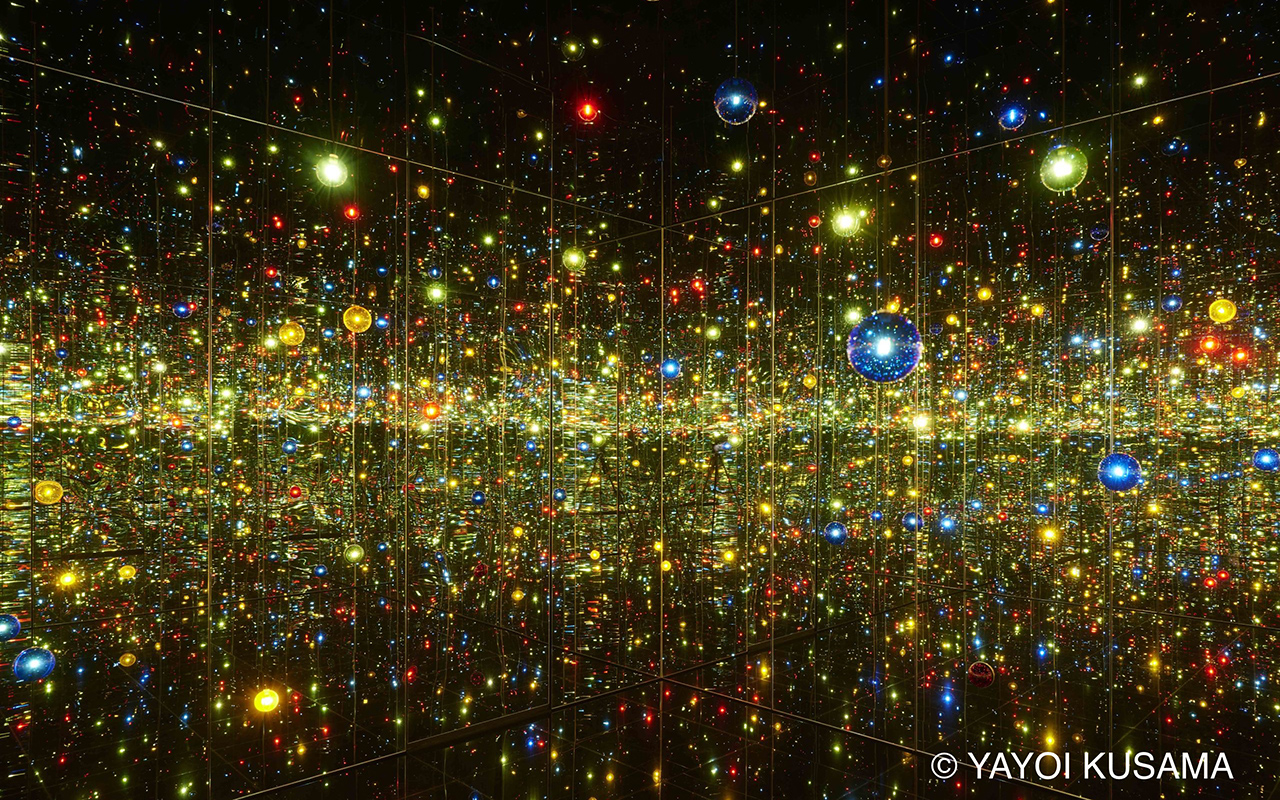
Yayoi Kusama. Infinity Mirrored Room – A Wish for Human Happiness Calling from Beyond the Universe, 2020. Mirrors, wood, LED lighting system, metal, acrylic panel. 293.7 × 417 × 417 cm. © YAYOI KUSAMA. Courtesy of Ota Fine Arts.
Some keys to understand Yayoi Kusama
Self portrait
Kusama ‘s work is based on self-affirmation , self-destruction , self-promotion , self-invention , self-referential and self-portrait, even in those creations where the representation of her own image is less explicit. This room brings together some of the paintings and drawings made by Kusama within the genre of the self-portrait, which occupies a prominent place in her production.
This section begins with Self-Portrait (1950), a dark painting in which a flesh-pink sunflower floats above a human mouth, and is one of the first works to be given that title; The space is presided over by her Portrait (2015), in which Kusama arranges some of her characteristic motifs —polka dots, pumpkins, nets and tentacular shapes— in a composition constructed as a collage and dominated by a hieratic figure.
Infinite
Kusama grew up in a seed nursery surrounded by vast fields of flowers. However, in 1957 while flying over the Pacific on her first flight to the US, the sight of the ocean inspired her well-known paintings of Infinity Webs. In this series, the canvases are obsessively covered in tiny arcs painted in one swift gesture, creating an expressionist pattern of interconnected dots and webs. The free brushstroke contrasts with the reiteration of the motif, which makes it impossible to identify the beginning and end of this universe without hierarchies, whose dimensions were expanding within Kusama ‘s production until the public was immersed in the infinity of her installations.
Accumulation
Kusama ‘s art , the concept of accumulation is not simply an obsessive-compulsive tendency, nor an innate desire for repetition, but can be interpreted as a desire for expansion driven by the artist’s need to broaden her creative vision.
After creating the ‘Infinity Nets’, Kusama developed ‘Accumulation’, a series of collages made with reused fragments of paper and soft sculptures in repetitive forms. In these pieces, an everyday object, such as a chair, is transformed by accumulating on it a large number of phallic and tubular shapes of stuffed and sewn fabric, which make the object itself and its function disappear. Little by little, the compulsive desire to multiply these soft shapes led Kusama to expand her vision to the mirrored rooms of infinity, which she began in 1965, and to the silver or patterned fabrics she made during the 1970s and 1980s, such as ‘Accumulation de manos’, where a sofa and chairs are covered in hundreds of silver gloves
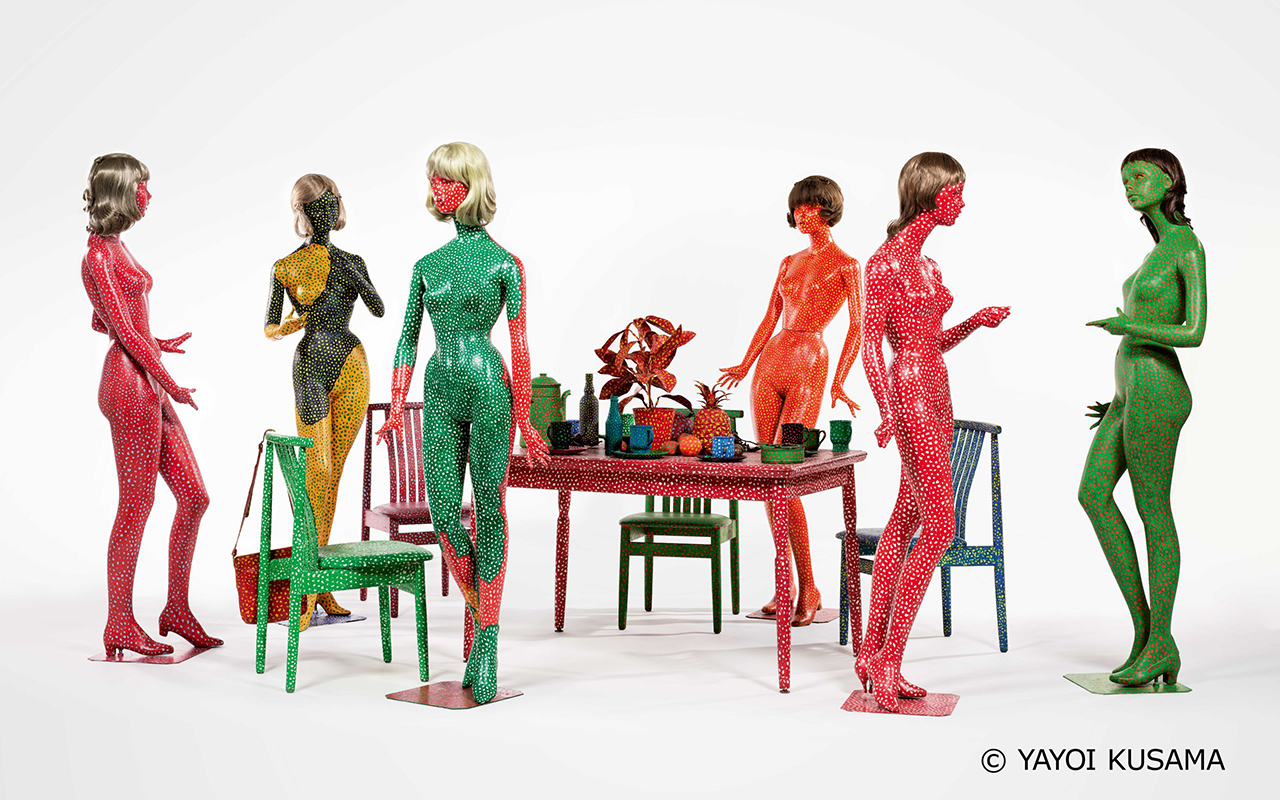
Yayoi Kusama. Self-Obliteration (Auto-obliteración), 1966–1974. Painting on mannequins, table, chairs, wigs, handbag, cups, plates, ashtray, pitcher, plastic plants, plastic flowers, plastic fruits. Variable dimensions. M+, Hong Kong. © YAYOI KUSAMA
Radical connectivity
In the late 1960s, the struggle for civil rights and the war in Vietnam generated a counterculture atmosphere in which Kusama developed a practice centered on public action and performance. The artist denounces race and gender stereotypes, criticizes the warmongering US policy and attracts the attention of the media with her provocative happenings, especially those featuring naked bodies covered with polka dots, which are acts of “self-obliteration”.
Kusama ‘s philosophy , which represents the liberation of the self as a form of group healing and deeply connects people, especially those who live on the margins of society. The Japanese artist uses the power of the media to spread her philosophy and intensify her visibility and notoriety.
Biocosmic
Where does your obsession with polka dots come from? Yayoi Kusama gives us the answer: “Our earth is just a mole among the millions of stars in the cosmos. Polka dots are a path to infinity. We erase nature and our bodies with polka dots, we integrate into the unity of our environment.”
Her childhood near her family’s plant nursery made the Japanese artist feel a deep bond with organic life, which the artist considers to be connected to the dimension and space of the cosmos. ‘Lo BiocĂłsmico ‘ expresses her belief that the earthly and the heavenly are the same. As a child, she begins to observe the anatomy of plants, their life cycles, and the union between heaven and earth. Perhaps the most consistent image of the biocosmic in her work is that of her distinctive gourds, with whimsically undulating and mottled surfaces, which Kusama identifies as a benevolent plant spirit and reflection of her own soul. Her stance towards nature illustrates how Kusama expresses her alienation from the world and her expansive need to commune with the cosmos.
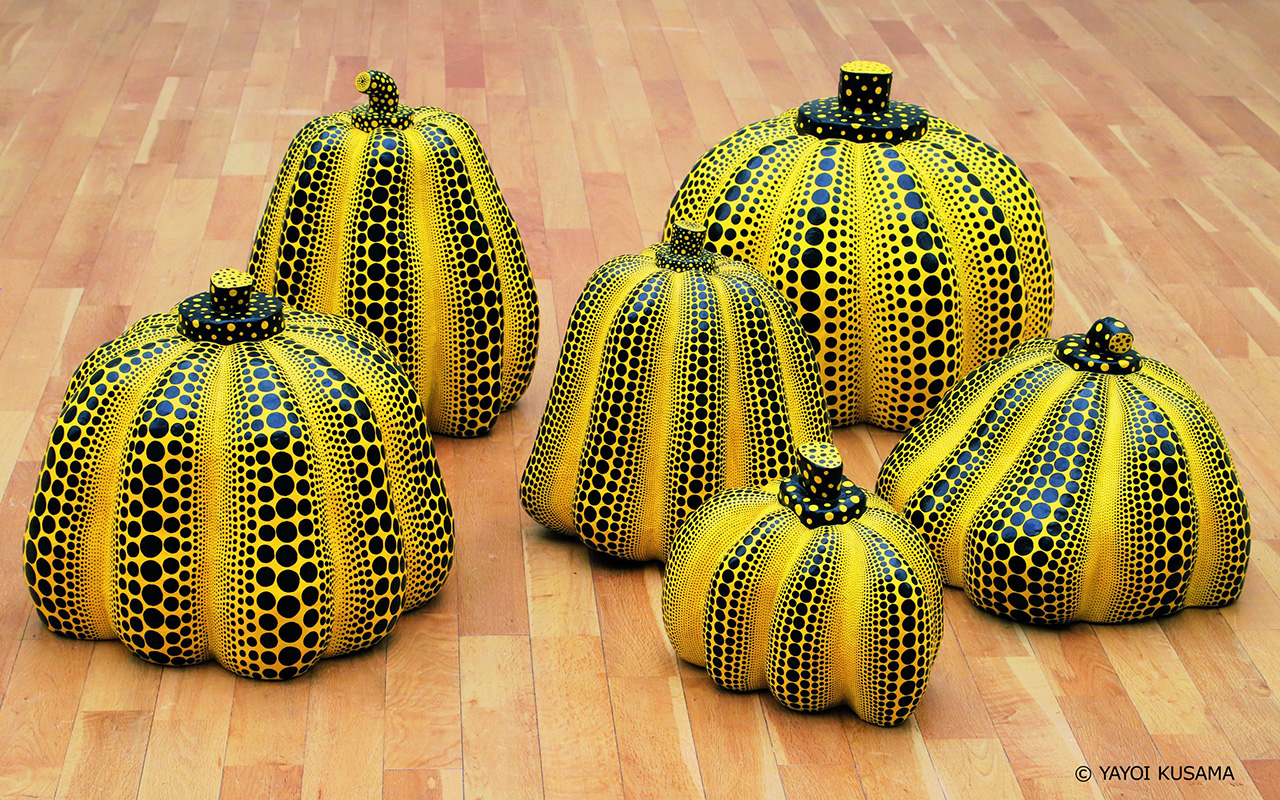
Yayoi Kusama. Pumpkins, 1998–2000. Mixed media. 6 pieces, variable dimensions. © YAYOI KUSAMA
Death
““What death means, its colours and its special beauty, the stillness of its footsteps and the ‘nothing’ after death. Now I am in a phase in which I create art for the rest of my soul, accepting all this”, says Kusama at the exhibition at the Guggenheim in Bilbao.
Kusama ‘s work is constantly on the threshold between life and death. A childhood surrounded by the ephemeral existence of plants in the family nursery, adolescence marked by the war and its consequences, and especially the death of her father and her close friend Joseph Cornell in the mid-seventies, led the artist to consider that death is not the end point, but another phase of existence that can give rise to a new one. Sometimes in her creative struggle and in despair, Kusama yearns to be free of what she describes as the “languorous weight of life.” However, through her artistic and literary practice, she transforms that desire into a kind of therapeutic fantasy, into a spiritual reward in the “solemn beauty” of death and in the loss of the ego as a return to eternity.
The force of live
Kusama ‘s art and psyche underwent a major change. With the arrival of the long-awaited and well-deserved public recognition, both from her international exhibitions and from her publications, praised in avant-garde literary circles, the healing power of art and the celebration of life become the central themes of her production. As she stated in 1999, Kusama came to believe that her role was to transform her suffering through art “for the healing of all humanity.” In the new millennium, the Japanese artist wants to amplify this message. For this reason, the colourful paintings and sculptures from one of her latest series, My Eternal Soul (2009–) and I Pray Every Day for Love (2021–today), perhaps represent the culmination of this commitment
The exhibition “Yayoi Kusama : from 1945 to today” will remain open to the public until October 8.
